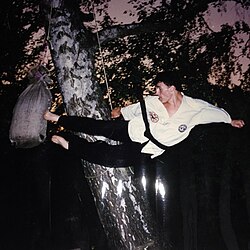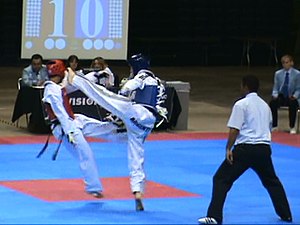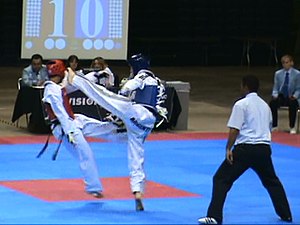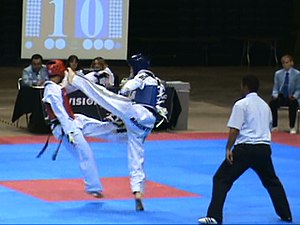The Most Difficult Taekwondo Kick, Ranked
Voting rules: Choose the kick you think is the most difficult!

Updated on May 25, 2024 06:34
Mastering Taekwondo requires not just physical prowess but a deep understanding of technique, particularly when it comes to executing kicks. These movements, often complex and demanding, vary significantly in difficulty. Assessing which kick tops the list as the most challenging can guide learners by setting clear milestones in their training progress.
By participating in ranking these kicks, practitioners contribute their insights, fostering a shared community resource that benefits everyone from novices to seasoned experts. This democratic approach provides a well-rounded perspective on the hurdles each kick presents, making it easier for all to pinpoint areas for personal growth and development.
What Is the Most Difficult Taekwondo Kick?
-
139votes
Flying Side Kick
A dynamic kick where the practitioner leaps into the air to deliver a powerful side kick.- Difficulty Level: High
- Movement: Leaping
-
28votes
Spinning Hook Kick
A kick that combines a spinning motion with a hooking action to strike the target.- Difficulty Level: High
- Action: Spinning and Hooking
-
30votes
Tornado Kick
A spinning kick that involves a 360-degree turn and is used to generate significant power.- Difficulty Level: High
- Rotation: 360 degrees
-
40votes
540 Degree Kick
A highly advanced spinning kick where the practitioner performs a full 540-degree rotation before landing the kick.- Difficulty Level: Very High
- Rotation: 540 degrees
-
50votes
Back Kick
A powerful kick delivered backward, towards the target, without looking.- Difficulty Level: Moderate
- Direction: Backward
-
60votes
Double Roundhouse Kick
A complex kick where the practitioner delivers two roundhouse kicks in rapid succession.- Difficulty Level: High
- Number of Kicks: Two
-
70votes
Jumping Spinning Back Kick
Combines a jump with a spinning back kick for increased power and surprise.- Difficulty Level: High
- Movement: Jumping and Spinning
-
80votes
Ax Kick
A downward kick that mimics the motion of an axe chopping, targeting the head or shoulders.- Difficulty Level: Moderate
- Direction: Downward
-
90votes
Spinning Crescent Kick
Involves spinning and delivering a wide, sweeping kick with the outer edge of the foot.- Difficulty Level: High
- Action: Spinning and Sweeping
-
100votes
720 Degree Kick
An extremely advanced kick involving two full rotations in the air before striking the target.- Difficulty Level: Extremely High
- Rotation: 720 degrees
Missing your favorite kick?
Graphs
Error: Failed to render graph
Discussion
No discussion started, be the first!
About this ranking
This is a community-based ranking of the most difficult Taekwondo kick. We do our best to provide fair voting, but it is not intended to be exhaustive. So if you notice something or kick is missing, feel free to help improve the ranking!
Statistics
- 3463 views
- 47 votes
- 10 ranked items
Voting Rules
A participant may cast an up or down vote for each kick once every 24 hours. The rank of each kick is then calculated from the weighted sum of all up and down votes.
Trendings topics
Don't miss out on the currently trending topics of StrawPoll Rankings!
Physical Fitness
Additional Information
More about the Most Difficult Taekwondo Kick

Rank #1 for the most difficult Taekwondo kick: Flying Side Kick (Source)
Taekwondo is a Korean martial art known for its high, fast kicks. Practitioners spend years perfecting their techniques. Among these kicks, some are very difficult to master. These kicks require not just strength, but also balance, flexibility, and precision.
Learning such a kick starts with understanding the basics. One must have strong foundational skills. This includes good posture, stable stances, and proper foot positioning. Without these, executing complex kicks becomes almost impossible.
Flexibility plays a key role. High kicks demand a wide range of motion in the hips and legs. Stretching exercises help improve this flexibility. Regular practice of splits, leg raises, and other stretches is essential. A flexible body can achieve the height and reach needed for these kicks.
Balance is another crucial factor. Maintaining balance while performing a kick is challenging. It requires strong core muscles. Practitioners often do balance exercises to strengthen their core. This helps them stay steady when they lift one leg and strike with the other.
Strength cannot be overlooked. Powerful legs are necessary to generate the force behind these kicks. Strength training, such as squats and lunges, builds the muscles needed. Strong legs also help maintain balance and control.
Precision is the final piece. A kick must hit its target accurately. This requires focus and practice. Drills that involve hitting specific targets can improve precision. Practitioners repeat these drills until they can hit the target consistently.
Executing a difficult kick involves combining all these elements. A practitioner must be flexible, balanced, strong, and precise. Each element supports the others. For example, good balance helps maintain precision. Strong legs support flexibility.
Practicing these kicks takes time and patience. Small improvements lead to mastery. Practitioners often break down the kick into smaller parts. They practice each part separately before combining them. This methodical approach helps them understand each element better.
In competitions, these kicks can be a game-changer. Judges look for height, speed, and accuracy. A well-executed kick can score high points. It can also intimidate opponents. However, the risk of failure is high. A missed kick can leave a practitioner off-balance and vulnerable.
Despite the difficulty, mastering such a kick is rewarding. It showcases a practitioner's dedication and skill. It also enhances their overall Taekwondo practice. The skills learned in mastering the kick can improve other techniques.
Instructors play a vital role in this process. They provide guidance and feedback. They help practitioners correct mistakes and improve their form. Their experience and knowledge are invaluable.
In conclusion, the most difficult Taekwondo kicks require a blend of flexibility, balance, strength, and precision. Mastering them is a journey that takes time and effort. It demands dedication and practice. But the rewards are worth it. Practitioners gain not just a powerful kick, but also a deeper understanding of their art.
Learning such a kick starts with understanding the basics. One must have strong foundational skills. This includes good posture, stable stances, and proper foot positioning. Without these, executing complex kicks becomes almost impossible.
Flexibility plays a key role. High kicks demand a wide range of motion in the hips and legs. Stretching exercises help improve this flexibility. Regular practice of splits, leg raises, and other stretches is essential. A flexible body can achieve the height and reach needed for these kicks.
Balance is another crucial factor. Maintaining balance while performing a kick is challenging. It requires strong core muscles. Practitioners often do balance exercises to strengthen their core. This helps them stay steady when they lift one leg and strike with the other.
Strength cannot be overlooked. Powerful legs are necessary to generate the force behind these kicks. Strength training, such as squats and lunges, builds the muscles needed. Strong legs also help maintain balance and control.
Precision is the final piece. A kick must hit its target accurately. This requires focus and practice. Drills that involve hitting specific targets can improve precision. Practitioners repeat these drills until they can hit the target consistently.
Executing a difficult kick involves combining all these elements. A practitioner must be flexible, balanced, strong, and precise. Each element supports the others. For example, good balance helps maintain precision. Strong legs support flexibility.
Practicing these kicks takes time and patience. Small improvements lead to mastery. Practitioners often break down the kick into smaller parts. They practice each part separately before combining them. This methodical approach helps them understand each element better.
In competitions, these kicks can be a game-changer. Judges look for height, speed, and accuracy. A well-executed kick can score high points. It can also intimidate opponents. However, the risk of failure is high. A missed kick can leave a practitioner off-balance and vulnerable.
Despite the difficulty, mastering such a kick is rewarding. It showcases a practitioner's dedication and skill. It also enhances their overall Taekwondo practice. The skills learned in mastering the kick can improve other techniques.
Instructors play a vital role in this process. They provide guidance and feedback. They help practitioners correct mistakes and improve their form. Their experience and knowledge are invaluable.
In conclusion, the most difficult Taekwondo kicks require a blend of flexibility, balance, strength, and precision. Mastering them is a journey that takes time and effort. It demands dedication and practice. But the rewards are worth it. Practitioners gain not just a powerful kick, but also a deeper understanding of their art.
Explore other rankings
Check out some of the other recommended rankings on StrawPoll and make your voice heard.





